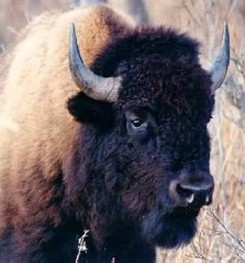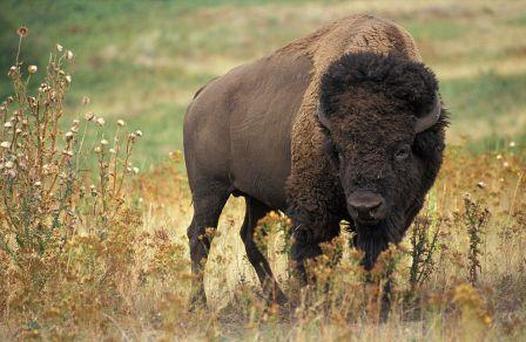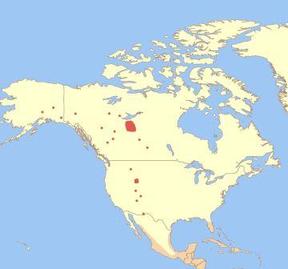American BisonBison Bison |

Custom Search
|
|
The American Bison (Bison Bison) also known as American Buffalo is the largest land animal in North America. It was once found in Western Canada, USA, in northeastern Mexico and probably in Alaska. Currently, is only found in protected areas of North America, such as Yellowstone National Park.
There are also herds that live in semi-freedom, in some large American ranches, but these are property of the owners of these lands. The American bison lives in prairies, plains and deciduous forests. The American Bison has a massive body and long wavy hair on the head and neck, extending over the withers and up to forefeet. The horns are relatively small and can grow up to 60 cm (2 feet) and are upturned. Males are larger than females. Their senses of hearing and smell are very refined. They live in matriarchal groups from 10 to 20 individuals, from which young males usually depart at around three years old. Adult males are solitary or live in small groups of males, and join the females only to mate. They may gather in large herds with thousands of individuals.
An adult male american bison can reach more than 3.6 meters long and 1.6 meters tall and weigh easily over 1000 kg. As With most ungulates, the male is slightly larger than the female bison.
The American bison's that live in the wild can have a life expectancy of around 20 to 25 years, but in captivity, they almost double that time and can live up to 40 years. American Bison - Diet Bison are herbivores and feed on herbaceous plants, and also of mosses and lichens in winter. In winter, they will use their head and hooves to move snow off the vegetation so they can feed. American Bison - Reproduction They breed in summer (July to September), so that births coincide with the greatest abundance of food. Males fight each other for the right to mate with females. The gestation period is approximately 285 days, after which is born a calf who is nursed for seven to twelve months. The calf can run to keep up with the mother a few hours after birth. The mother defends it fiercely. They reach sexual maturity between two and four years old. American Bison - Conservation status and main threats
The American bison lived in large herds, and the species was respected by the Native Americans, since from their skin they made clothing and tents and the meat was the base diet of these people. Every tribe would kill only the animals strictly necessary for their survival but the arrival of white European settlers who killed animals indiscriminately, almost led to the extinction of the American bison. This species is at risk and conservation dependent, according to the International Union for Conservation of Nature. It is estimated that there were up to 50 million individuals in North America. The massive hunt that the species was subject for meat and trophies took her to the brink of extinction, at the beginning of the century. XIX. Currently, their survival can be guaranteed only in protected areas.
|
Scientific classification
Kingdom: Animalia Phylum: Chordata Subphylum: Vertebrata Class: Mammalia Order: Artiodactyla Family: Bovidae Subfamily: Alcelaphinae Genus: Connochaetes Species: C. taurinus |



